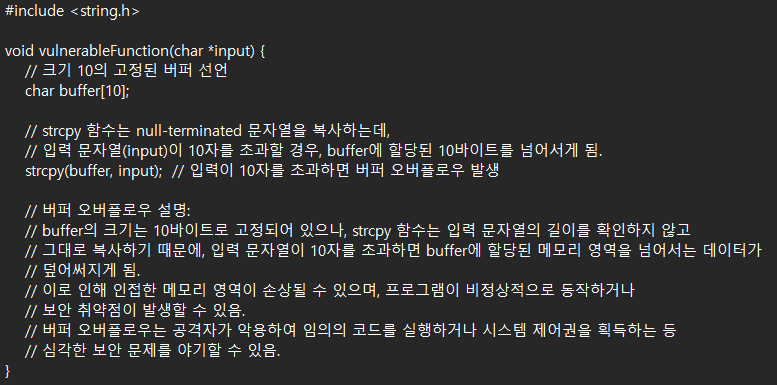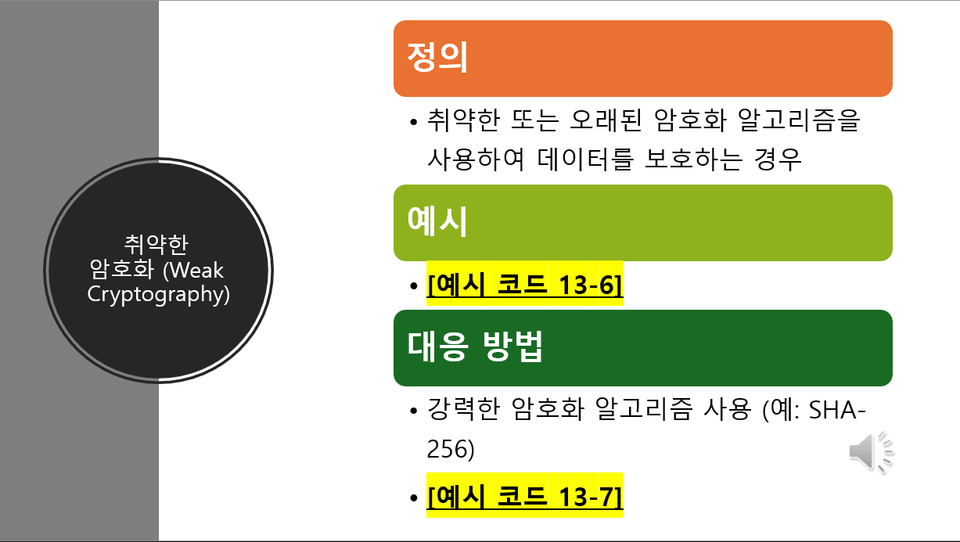
A Quick Overview of C Language
arigaram
You can quickly understand C language's basic concepts and grammar.
Beginner
C, Embedded
This lecture is designed for understanding even if you have no prior knowledge of what Secure Coding (Security Coding) is. After covering basic security coding concepts, it focuses on web service security. This was a special lecture presented under the auspices of OO University. It presents over 160 source codes with rich comments, pinpointing core topics and techniques immediately applicable in practice.
90 learners
Level Basic
Course period Unlimited


You can thoroughly understand secure coding.
You can learn web security, authentication and authorization, and code review methods for security.
You can learn language-specific security flaws & solutions.
The course is currently being completed. Please note that you may have to wait a long time until the course is fully finished (although updates will be added regularly). Please consider this when making your purchase decision.
September 18, 2025
I added precautions and change history to the detailed introduction page.
In modern software development, security is not optional but essential. This course enables you to systematically learn and practice Secure Coding techniques, which are core competencies for developing secure software. Designed for all IT professionals interested in security, including developers, security personnel, and QA engineers, this course is excellent for use in security training. (Keywords: security training, penetration testing, security)
Chapter 1. Orientation
Chapter 2. The Three Pillars of Information Security
Chapter 3. The Role of Security in Software Development
Chapter 4. Case Studies: Analysis of Notable Security Incidents
Chapter 5. The Concept of Threat Modeling
Chapter 6. Introduction to the STRIDE Model
Chapter 7. Introduction to the DREAD Model
# Chapter 8. Threat Modeling Tools
# Chapter 9. Practice: Threat Modeling Application Examples
Chapter 10. Secure Coding Standards (CERT, OWASP, etc.)
# 11-1. Guidelines for Safe Coding
11-2. Input Validation and Writing Clean Code
11-3. Practice: Writing Safe Input Handling Code
# Chapter 12. Security Vulnerabilities in C/C++
# Chapter 13. Security Vulnerabilities in Java
# Chapter 14. Security Vulnerabilities in Python
# Chapter 15. Memory Management and Buffer Overflow
Chapter 16. Format String Vulnerability
# Chapter 17. Practice: Writing Safe Memory Management Code
# Chapter 18. Object Serialization and Security
# Chapter 19. SQL Injection and Countermeasures
# Chapter 20. Practice: Writing SQL Injection Defense Code
# Chapter 21. Dynamic Typing and Security
Chapter 22. Security Issues with the Pickle Module
# Chapter 23. Practice: Writing Secure Data Serialization Code
Chapter 24. The Importance of Web Security
# Chapter 25. OWASP Top 10 Overview
Chapter 26. Concept and Types of XSS
Chapter 27. XSS Defense Techniques
Chapter 28. Practice: Writing XSS Vulnerability Defense Code
Chapter 29. CSRF Concepts and Attack Methods
30. CSRF Defense Techniques
# Chapter 31. Practice: Writing CSRF Defense Code
# 32. How to Configure Security Headers
# Chapter 33. The Importance of HTTPS and How to Configure It
# Chapter 34. The Difference Between Authentication and Authorization
Chapter 35. Secure Authentication Methods
# 36-1. Understanding Passwords and Salt
# 36-2. Secure Password Storage Techniques
Chapter 37. Practice: Password Management through Hashing and Salting
# Chapter 38. The Concept of OAuth and Use Cases
# Chapter 39. The Concept and Usage of JWT (JSON Web Token)
Chapter 40. Implementing Authentication Using JWT
# Chapter 41. Secure Session Management Techniques
42. Methods to Prevent Session Hijacking
# Chapter 43. The Importance of Code Review
# Chapter 44. Utilizing Static Analysis Tools
# Chapter 45. The Concept of Dynamic Analysis
# 46-1. Penetration Testing Tools
46-2. Penetration Testing Execution Phases
# Chapter 47. Practice: Simple Penetration Test Simulation

Approximately 160 richly annotated code examples are provided.

The book presents vulnerable code alongside code with reinforced security measures. Since specific countermeasures for addressing vulnerabilities are provided in detail, you can apply them directly to your practical work.

For example, sample code 13-6 contains vulnerable code.

Meanwhile, Example Code 13-7 contains code with reinforced vulnerabilities.
Acquiring Basic Principles and Practical Skills for Writing Secure Code
Understanding and securing capabilities to respond to security vulnerabilities by language and platform
Strengthening Key Threat Response Capabilities Related to Web Security and Authentication/Authorization
Acquiring Practical Knowledge for Establishing a Security Culture within Development Organizations
Prevention is the best approach to security incidents. Start now.
Take your first step in secure coding with this course!
Who is this course right for?
A person who wants to know what Secure Coding is
Person wanting to solidify Secure Coding fundamentals
Someone who must immediately patch web application vulnerabilities
A person eager to learn immediately practical techniques.
Need to know before starting?
It's a plus if you understand one or two of C, Java, Python, Javascript languages.
580
Learners
30
Reviews
2
Answers
4.5
Rating
17
Courses
IT가 취미이자 직업인 사람입니다.
다양한 저술, 번역, 자문, 개발, 강의 경력이 있습니다.
All
209 lectures ∙ (19hr 28min)
Course Materials:
All
8 reviews
5.0
8 reviews
Reviews 3
∙
Average Rating 5.0
Reviews 2
∙
Average Rating 5.0
Reviews 1
∙
Average Rating 5.0
Reviews 2
∙
Average Rating 5.0
Limited time deal ends in 6 days
$58.30
24%
$77.00
Check out other courses by the instructor!
Explore other courses in the same field!